Check out these amazing hotel deals!
- Save up to 30% on your hotel in Hawaii!
- Last-minute holiday hotel deals
- Top hotel deals for a new year trip
- Visiting Paris? Find the Best Deals & Reviews at TripAdvisor.
- Save 30% on hotels in Ocean City, Maryland...a TripAdvisor Top 10 Summer Destination!
- Save up to 30% on your hotel on your Winter Vacation!
- Find top-rated hotels at the lowest prices on TripAdvisor. Check rates now!
- Save up to 30% on hotels for a romantic getaway!!
Temples are architectural structures used as a place of worship. The term “temple” derives from the Latin templum which means consecrated enclosure. There are many temples around the world. The Christian religion also has its temples, which are called churches. We know the mesmerizing beauty of the ancient domes and cathedrals of the great European cities and up to the most picturesque country churches.
Since we have already dedicated several articles to churches in the past, you won’t find any of them on this list. Instead, we admire and discover the most beautiful temples in the world and their relation with ancient religions lost over the centuries. Are you ready?
15. Temple of Hephaestus – Athens, Greece
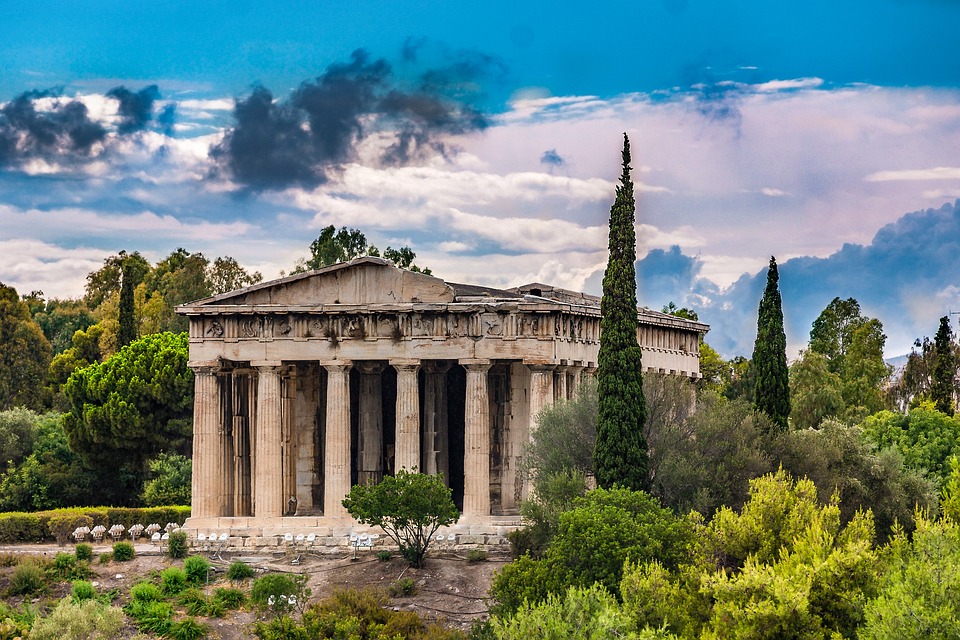
Religion: Ancient Greek
Year of construction: 5th century BC
The Hephaisteion, or Temple of Hephaestus, is located just above the ancient Agora. It’s one of the best-preserved Doric temples in the world despite being less famous than the nearby Parthenon. Contrary to what often happens with ancient buildings of worship, it does not seem to have replaced any previous temple. It has 13 columns on the long sides (according to the canonical proportion of the Doric temple, which places a double number of columns plus one on the longer sides compared to the front).
Inside, the cell probably had a double colonnade that ran on the two long sides and, on the bottom, acting as a scenic backdrop for the group of the two statues of Athena and Hephaestus made by Alcamene between 421 and 415, on a limestone base of Eleusis and marble reliefs. The metopes, 10 on the foreside and 24 on the eastern part of each of the long sides, represent the labors of Heracles and the exploits of Theseus. The friezes, on the other hand, show 23 figures engaged in a battle scene in the presence of 6 divinities seated on two groups of large rocks. A wonderful work that comes to us from the distant past.
14. Sravanabelagola Jain Temple – Bangalore, India
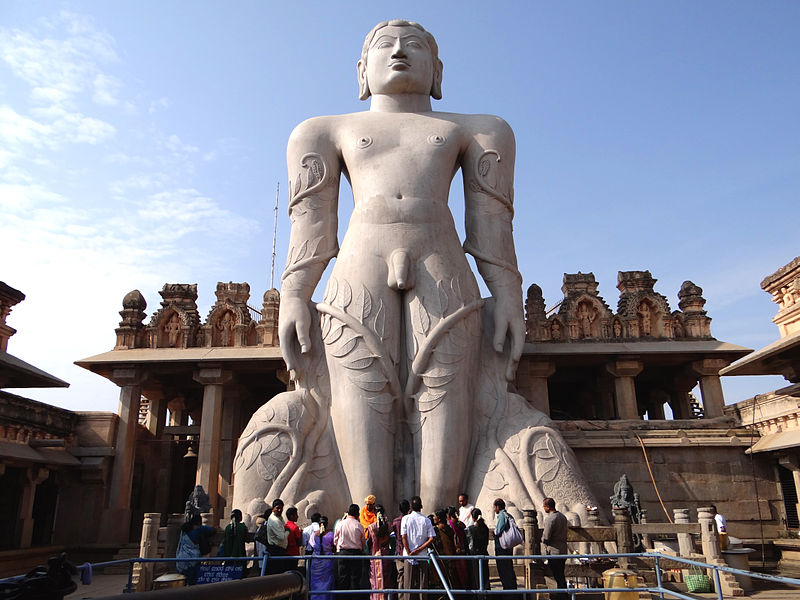
Religion: Jainism
Year of construction: more than 2000 years ago
What makes this temple unique is the huge monolith of Gommateswara Bahubali, near the Vindhyagiri hill, built around 1000 years ago. It’s a very important pilgrimage destination for the believers of Jainism (an ancient Indian religion). This place has been sacred for more than 2000 years and it’s said that Chandragupta Maurya (founder of the homonymous dynasty) has died right there in 298 BC after becoming a Jain monk and accepting a strictly ascetic lifestyle.
13. Batu Caves – Selangor, Malaysia
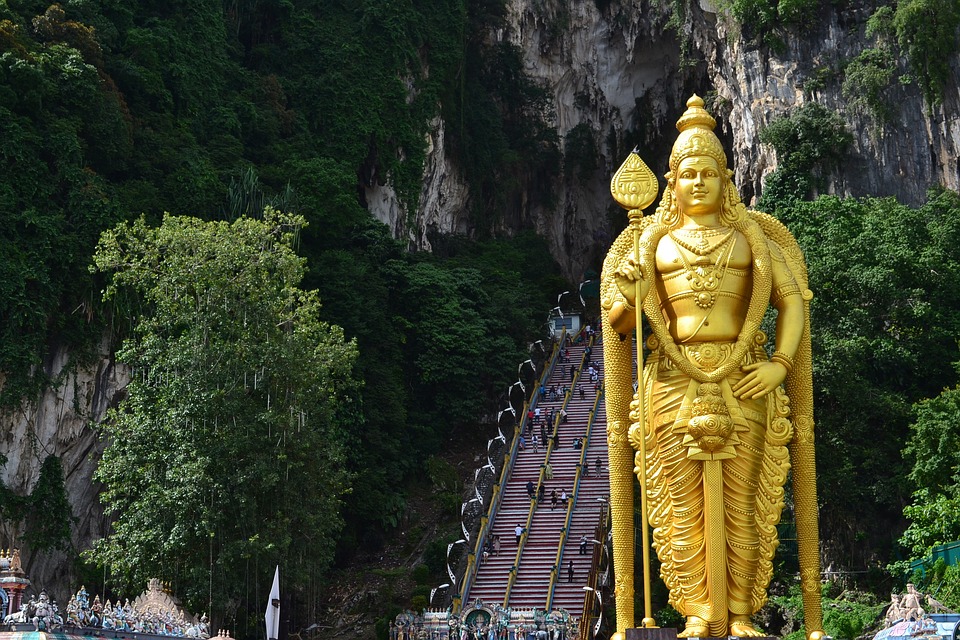
Religion: Hinduism
Year of construction: 1891
A mysterious place that, at the same time, reflects everything we imagine to find in a Hindy temple. It’s the largest Hindu place of worship outside India. It’s not antique but has a strong vintage aura and it’s absolutely spectacular. Unlike other places, taking photos here isn’t considered taboo. It consists of various buildings, chapels, and statues.
The most interesting is Murugan, with its 42 meters of height and gilded surface, which was placed in 2006. The most impressive environment is definitely represented by the Grotto. Although there are 272 steps and some unpleasant monkeys waiting for you, once you overcome those obstacles, you will reach the cave-chapel. Murugan shines due to the sun’s rays at the entrance and protects the cave as the lord of Love, Wisdom, and War.
12. The Hanging Temple – Datong, China

Religion: Buddhism, Confucianism, Taoism
Year of construction: 491 AD
You will find this temple-monastery literally clinging to a mountain, Mount Heng, (one of the 5 sacred mountains for Chinese Taoism) 50 meters above the ground. It’s the only monastery in China to contain three different religions in the same place. It has almost 40 spaces between halls and pavilions.
The Hanging Temple was originally built without the aid of wooden poles which serve as a support today. They were added only after construction because no one at that time had the courage to enter since they were afraid of it falling. In reality, the temple-monastery has never had problems and has always been safe to the extent that the poles that seem to support it today are movable and can be removed at any time.
The Temple can be reached by crossing a bridge that leads to a staircase carved along the rocky wall of the mountain. There are 6 main rooms, all connected in an intricate and ingenious way thanks to corridors, bridges, and paths that offer a truly breathtaking view, creating an even greater awareness of being a suspended monastery. The interiors contain a collection of 80 statues in bronze, stone, or terracotta each having enormous artistic and symbolic value.
11. Mahabodhi Temple – Bodh Gaya, India

Religion: Buddhism
Year of construction: about 250 BC
This is the place where Siddhartha Gautama, Buddha, attained enlightenment. Next to the temple stands the sacred Sri Maha Bodhi, born from the Bodhi tree (i.e. Illumination), the Ficus specimen under which Buddha was meditating when he was caught by enlightenment. Buddha then spent the next 7 weeks in 7 different places nearby meditating and pondering his experience. These seven points are now all places of worship in the Mahabodhi Temple. The Buddhist emperor Ashoka visited Bodh Gaya intending to build a monastery and an altar there and had a throne of diamonds built at the supposed point of enlightenment.
The Mahabodhi Temple is built of brick and it’s the oldest surviving structure of its kind in eastern India. It’s considered an excellent example of Indian architecture. The central tower is 55 meters high and was extensively renovated in the 19th century. It’s surrounded by 4 smaller towers built in the same style. The Temple is surrounded by stone railings, in sandstone (the older) and rough granite. The ancient railings feature scenes such as Lakshmi, the Hindu goddess of abundance, bathing with elephants, and Surya, the Hindu god of the sun, driving a chariot driven by four horses. The more recent ones, on the other hand, show figures of stupa (reliquary altars) and garuda (divine eagles), as well as images of lotus flowers.
10. Gawdawpalin Temple – Bagan, Myanmar
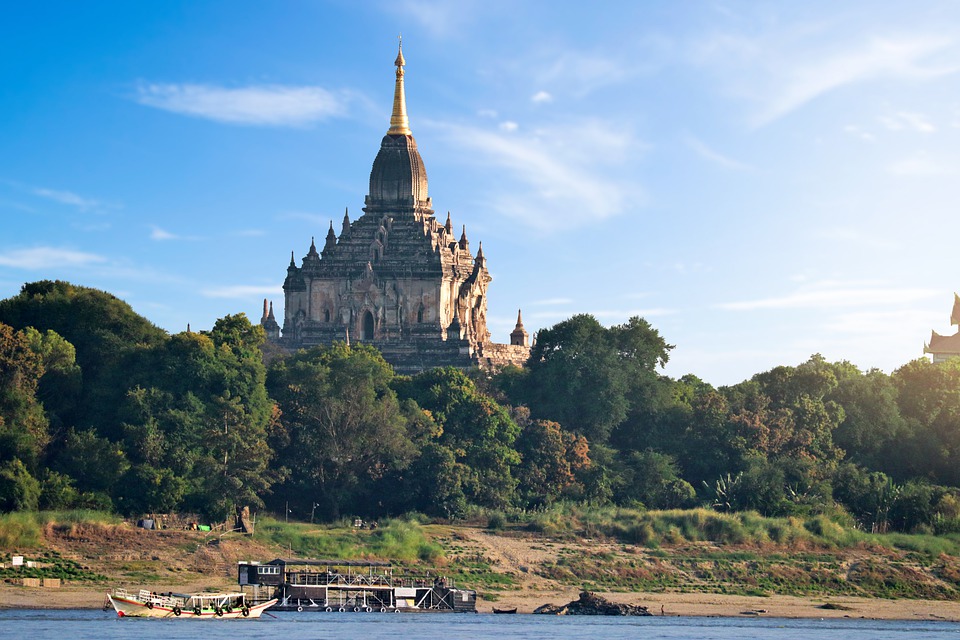
Religion: Buddhism
Year of construction: during the reign of Narapatisithu (1174-1211)
It is the second-largest temple in the area. It’s similar to Thatbyinnyu Temple, with two floors and several terraces. It is a structure used for meditation, to venerate Buddha, and perform sacred rituals. It is richly decorated and has beautiful rooms with arches and vaults.
9. Thatbyinnyu Temple, Bagan, Myanmar
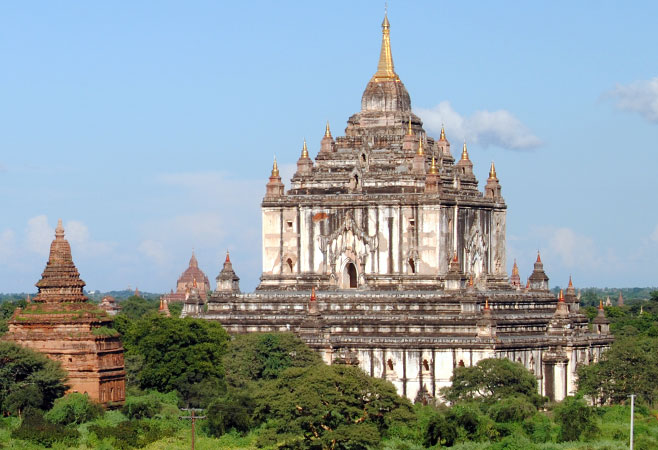
Religion: Buddhism
Year of construction: XII century
Thatbyinnyu Temple (Temple of Omniscience) is a temple the construction of which began during the reign of King Alaungsithu, around the middle of the 12th century. The building was erected not far from the Ananda Temple (its construction began less than a century earlier). This temple has an irregular and asymmetrical cross shape. Its structure is on two floors, with a Buddha statue placed on the second floor. The temple reaches a maximum height of 61 meters and is the tallest in the area.
8. Abu Simbel – Aswan Governorate, Egypt
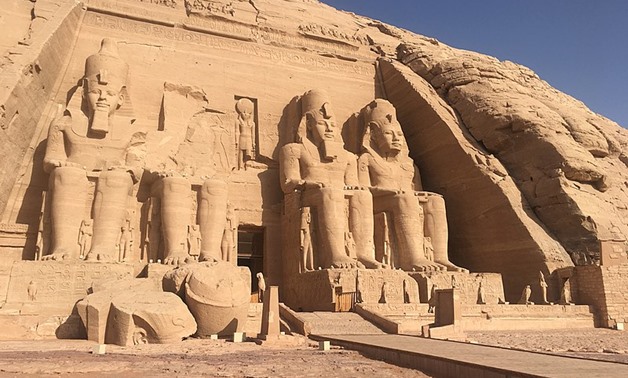
Religion: ancient Egyptian cult
Year of construction: 19th dynasty of Egypt
It’s an archaeological complex consisting mainly of two huge rock temples carved out of the mountainside, built in the 13th century BC. They were erected to intimidate the Nubian neighbors and commemorate the victory in the Battle of Qadesh. It was discovered on 22 March 1813 by the Swiss Johann Ludwig Burckhardt but it was almost completely covered with sand, which is why it was violated for the first time on 1 August 1817 by the Italian archaeologist Giovanni Battista Belzoni. In 1979 it was recognized as a UNESCO World Heritage Site.
The construction of the temple began in the 26th year of the reign of Ramses II on the occasion of the second jubilee to deify himself. Richly decorated, both outside and inside, it has four statues of Ramses II on the facade (33 meters high and 38 wide), each 20 meters high. In each one, the pharaoh wears the pschent (the crowns of Upper and Lower Egypt), the headdress called nemes, which falls on his shoulders, and carries the cobra on his forehead. On the sides of the colossal statues, there are other smaller ones: his mother Tuya and his wife Nefertari. Between the legs are the statues of some of his children, recognizable by the childish braid on the side of the head. On the pediment of the temple, there are 14 statues of baboons that, looking east, expect every day the birth of the sun to adore it. A legend says that Queen Nefertari has died at the entrance to the great temple, but it’s almost certain that she has died before the completion of the structure.
7. Swaminarayan Akshardham Temple – New Delhi, India
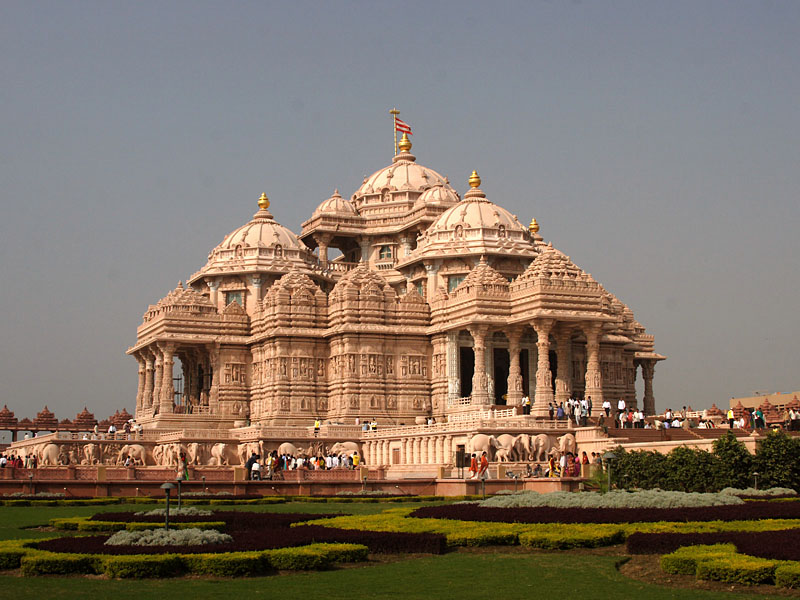
Religion: Hinduism
Year of construction: 2005
It is one of the largest Hindu temples in the world. Akshardham means “house of the supreme God”. This huge temple, or mandir, is decorated with elegantly carved columns and nine domes. Its decorations include stone elephants and statues depicting gods and personalities from Indian history. Made of pink stone and white marble, materials that symbolize purity and peace, this temple reaches a height of 43 meters and a width of 108 meters. Given its grandeur, this temple is located in an area of 40 hectares.
6. Temple of Heaven – Beijing, China
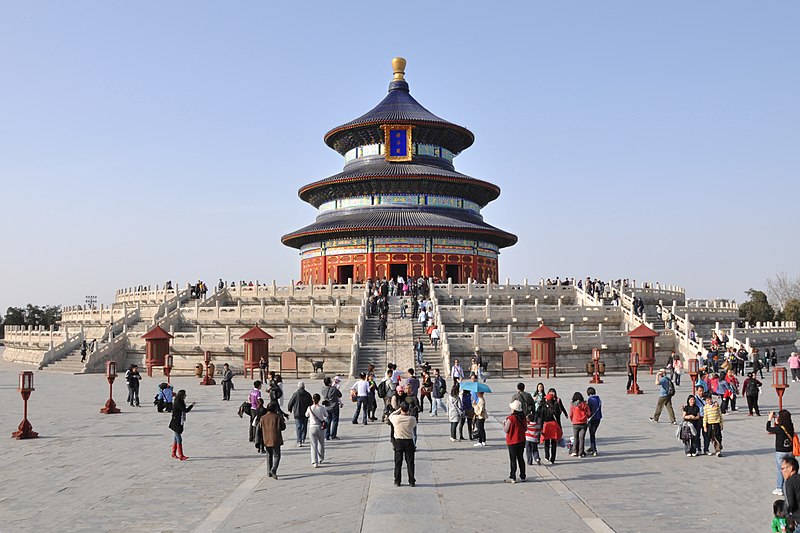
Religion: Taoism
Year of construction: 1420
The Temple of Heaven is a complex of Taoist cultural buildings located in the southern part of Beijing. The temple was used for worship officiated by the emperor of Heaven (Tian), the main deity of traditional Chinese religion. Moreover, the emperor was called “son of heaven”, governing, both, the people and the country in this capacity.
The complex covers an area of 2.73 square kilometers and comprises three main groups of buildings. The main points of interest are the Altar of Heaven, the temple of prayer for a good harvest, the courtyard of sacred music, and the stables of sacrificial animals. In the construction of the temple, the ancient master craftsmen have shown unparalleled skill. The imperial buildings have mainly yellow majolica tiles, a symbol of imperial power, whereas the buildings of the Temple of Heaven have blue tiles. In 1998, the Temple of Heaven became a UNESCO World Heritage Site.
5. Golden Temple – Amritsar, India
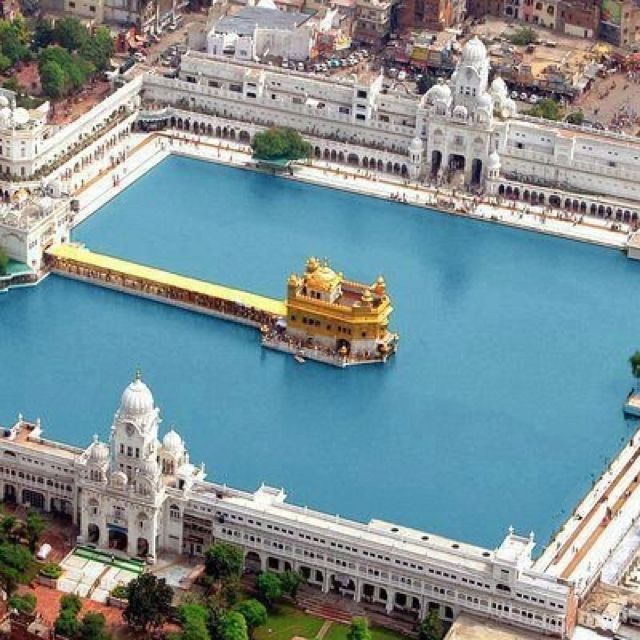
Religion: Sikh
Year of construction: 1588
The Sikhs consider it the holiest temple of their religion. It’s also a pilgrimage destination where every believer should go at least once in their life to pray and offer their pleadings. Currently, the temple is a world-class tourist attraction.
The property is surrounded by a small water lake, known as Sarovar, which consists of Amrit (Holy Water). There are four entrances to the temple, which symbolize the importance of acceptance and openness. Anyone who wants to enter can do so, regardless of religion, color, creed, or gender. The only restrictions are that the person must not drink alcohol, eat meat, smoke cigarettes, or other drugs while in the sanctuary. When entering everyone must cover their heads as a sign of respect and wash their feet in the small lake.
Much of the current gilding and marble works date back to the early 1800s. All the works in gold and marble, of exquisite workmanship, were made under the patronage of Emperor Ranjit Singh, Maharaja, and an important donor of wealth and materials for the sanctuary. He is remembered with great affection by the Punjabi people in general and by the Sikh community in particular.
4. Borobudur – Java, Indonesia
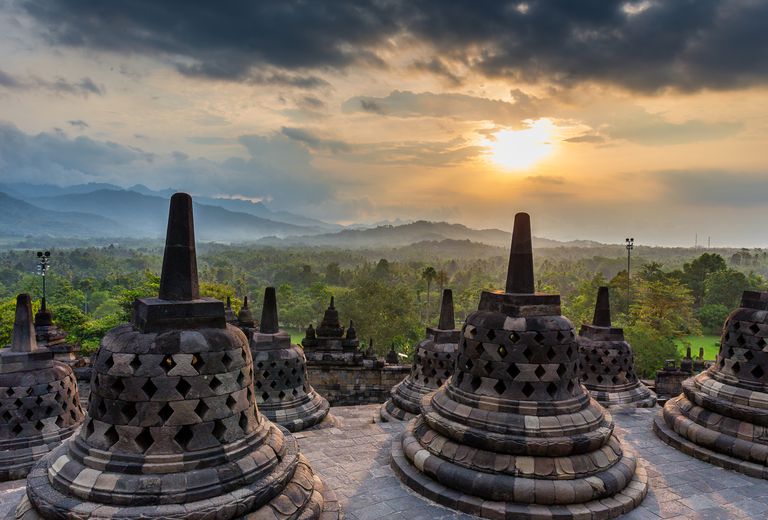
Religion: Mahāyāna Buddhism
Year of construction: between 750 and 830 AD
It’s a huge temple with a 123 x 123 meters base, 35 meters height, and resting on approximately 1,600,000 colossal stone blocks. Its walls are covered with 2672 bas-reliefs. Borobudur is the most visited monument in entire Indonesia.
The choice of location was carefully planned as the area reminds of several sacred places for the population. Namely, the confluence of two rivers reminds of that of the Ganges and Yumna and the mountain range is similar to the profile of the Himalayas. After the war between the Dutch and the British for the possession of Java, the island was under British control from 1811 to 1816. Governor Thomas Stamford Raffles, a great lover of archeology and local history, learned of the legend of the temple-mountain and decided to do research.
The temple is highly symbolic. It’s structured in 10 terraces(corresponding to the 10 phases of the spiritual journey towards perfection), divided into three groups (the three realms of saṃsāra). The entire path is characterized by the constant and repeated presence of niches containing statues of Buddha, with each being different from the others. Walking around, the devotee meditated along the successive terraces rich in progressive teachings, accumulating merits, and progressively freeing himself from “worldliness”, thus finally reaching the liberation of suffering or nirvāṇa, represented by the top of the monument.
3. Confucius Temple – Beijing, China
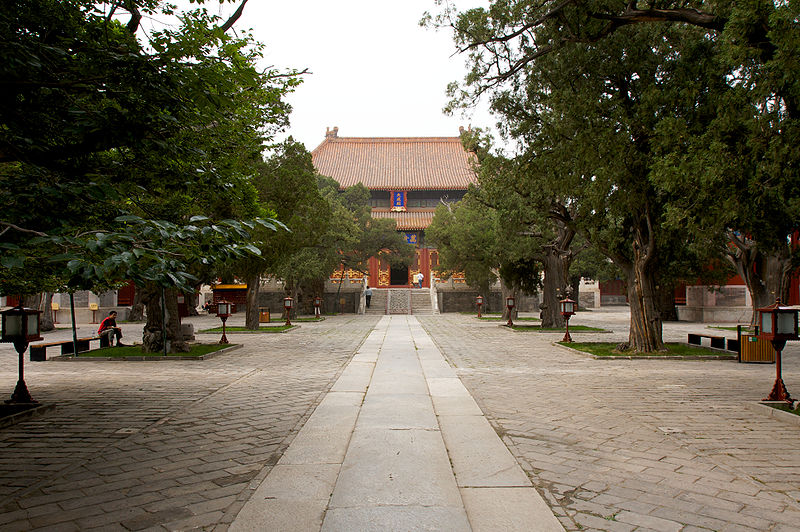
Religion: Confucianism
Year of construction: 1032
The construction of the Confucius Temple began in 1032 and continued until 1036. The main building, decorated with yellow enamel tiles, is a symbol of the highest construction standards for society at the time. The temple was a worthy demonstration of the status of the royal family. It covers 20,000 square meters, has 4 separate courtyards, and owns several buildings and pavilions. On both sides, there are 198 tombstones built during the Yuan, Ming, and Qing dynasties. The Confucius Temple contains several splendid collections and is famous for its stone sculptures, precious historical and cultural testimonies.
2. Uluwatu – Bali, Indonesia
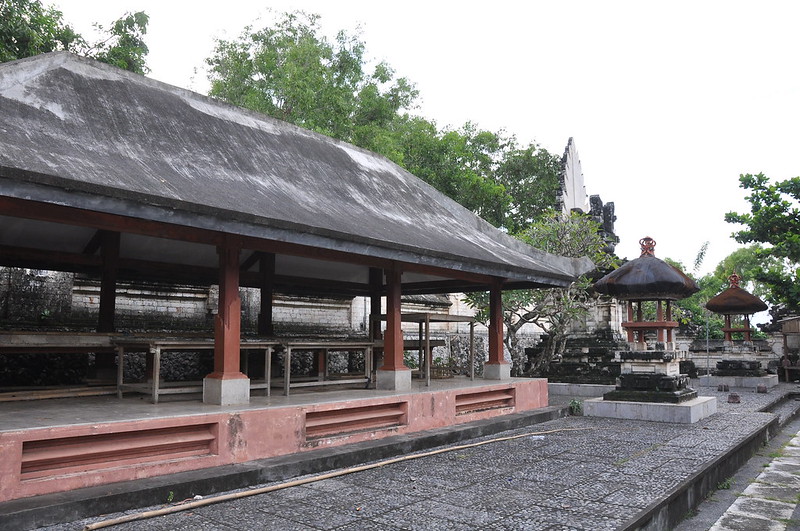
Religion: Java Hinduism
Year of construction: 10th century
It’s a temple you don’t expect to find! It sits perched on a cliff, with the blue waters of the Indian Ocean crashing into the rocks far below. The endless expanse of the sea in front of you and the lush green forest behind you will make you feel like you are on the far edge of the Earth. Inside the temple, there are traditional Balinese statues and a courtyard with offerings of fresh fruit and flowers. It is a touristy but quiet place. The view from up there leaves you speechless and gives a sense of serenity. The whole area is inhabited by monkeys that love to play with tourists and steal items such as hats and sunglasses. Besides this, the temple is dedicated to the spirits of the sea and is one of the oldest on the island.
1. White Temple – Chiang Rai, Thailand
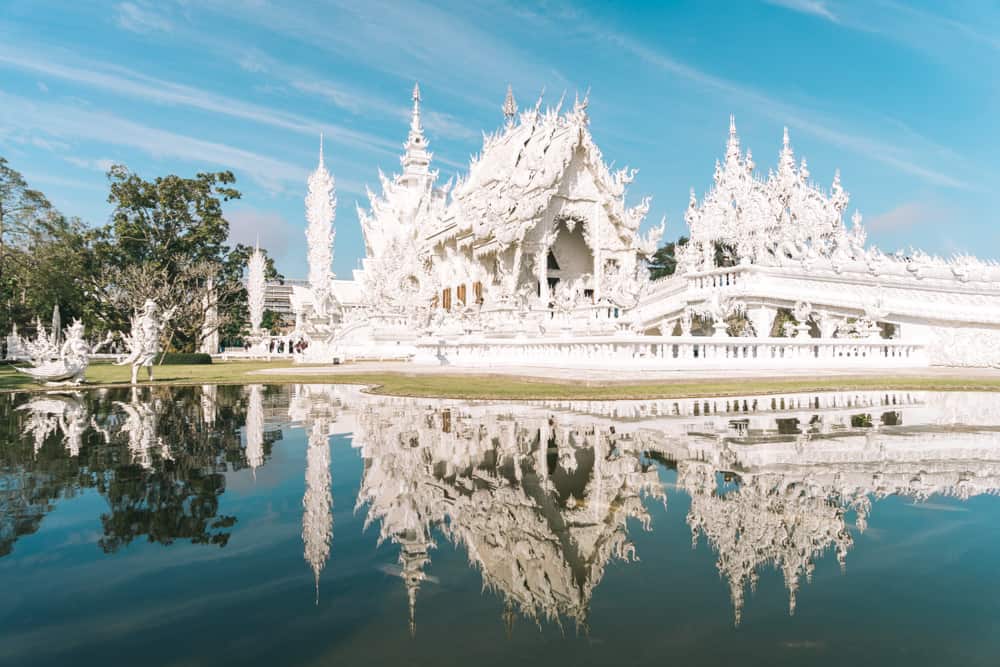
Religion: Theravada Buddhism
Year of construction: 1997
A crazy and almost absurd temple! You will definitely not find such construction with ancient religious concepts elaborated in a modern way anywhere else in the world. It’s made entirely of white plaster and mirrors which, reflecting the sun, create plays of light. This has been criticized by the local populations as against the tradition of an architectural style based on vivid and gaudy colors. However, the white color is not accidental: it represents the purity of Buddha. In addition to the extreme candor, the dozens of eager hands that will welcome you near the crossing point of the bridge that leads to the entrance will amaze and disturb you at the same time.
An ocean of arts emerges from a circular basin as if they came from beyond the grave. It is an image of desire which, according to Buddhist thought, is nothing other than the primary cause of all suffering. All the sculptures and structures of the temple have a symbolic meaning that wants to make the visitor reflect on Buddhist teachings. The bridge leading to the entrance symbolizes the passage from the world of temptations to the reign of the Buddha and, then, to liberation, i.e. nirvana. But that’s not all!
You will also find creepy old creatures (symbol of the impermanence of life), brilliant statues of Yama (god of death), and Rahu (god of darkness) who have the task of intimidating humans and deciding their fate by granting them entry into the reign of the Enlightened One or pushing them back to yet another reincarnation. Of course, there are Buddha images with countless details.
Inside, you will find something you never imagined. Namely, the traditional paintings have been enriched with murals depicting apocalyptic scenes from the modern world, including the fall of the Twin Towers and images from space starring some of the most famous characters from films and cartoons (Spiderman, Superman, Kung Fu Panda, Doraemon, Neo from The Matrix, Elvis, and Michael Jackson)!
Check out these amazing hotel deals!
- Save up to 30% on your hotel in Hawaii!
- Last-minute holiday hotel deals
- Top hotel deals for a new year trip
- Visiting Paris? Find the Best Deals & Reviews at TripAdvisor.
- Save 30% on hotels in Ocean City, Maryland...a TripAdvisor Top 10 Summer Destination!
- Save up to 30% on your hotel on your Winter Vacation!
- Find top-rated hotels at the lowest prices on TripAdvisor. Check rates now!
- Save up to 30% on hotels for a romantic getaway!!
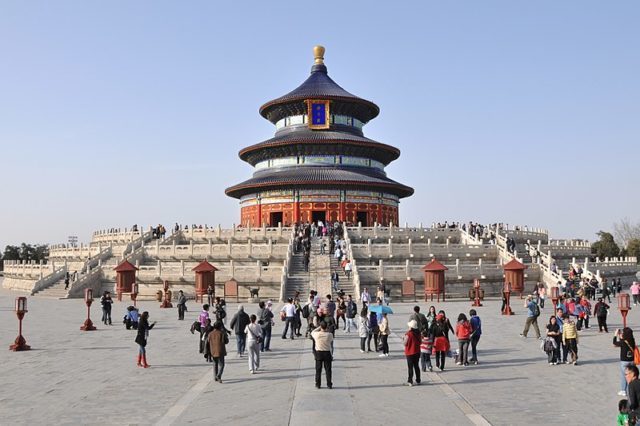


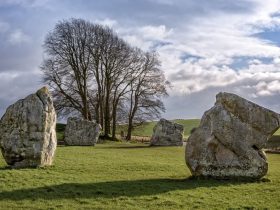


Find Us on Socials